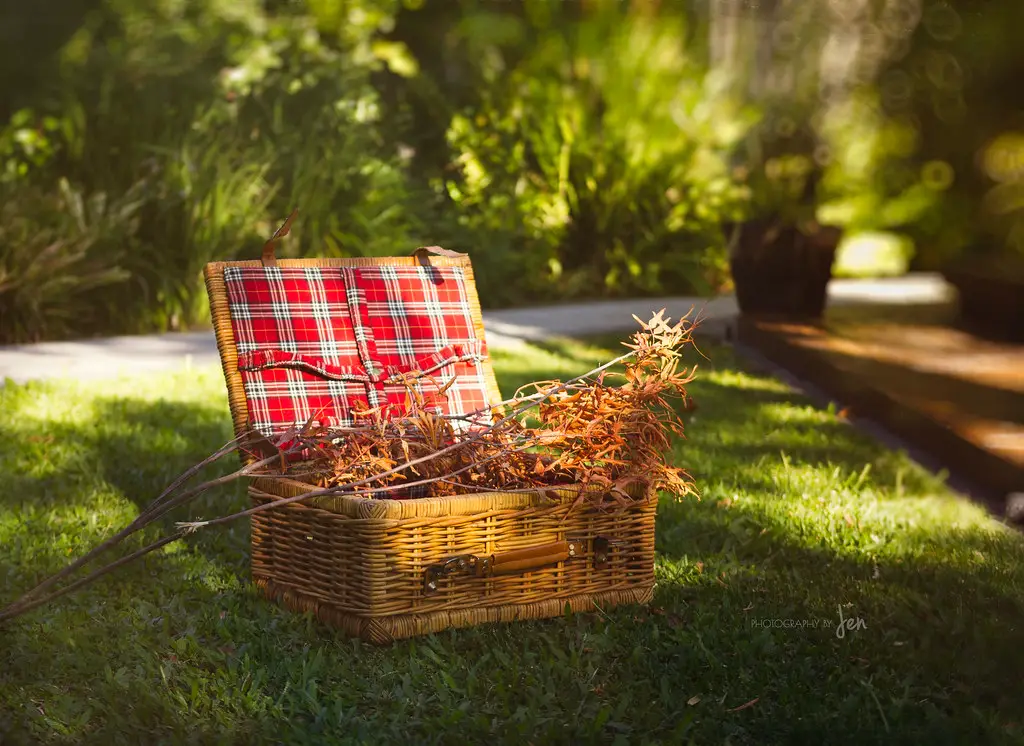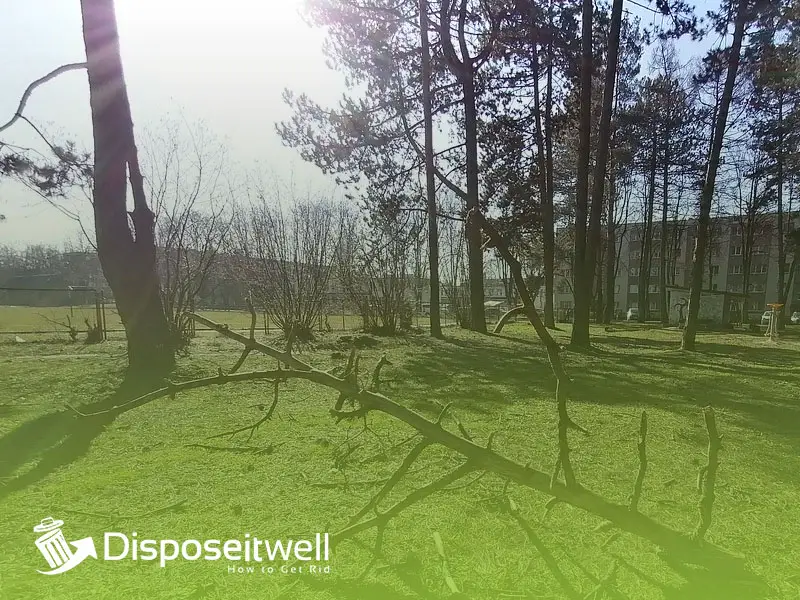After a long winter, it’s finally time to get outside and tidy up your yard. Part of that may include trimming tree branches. But once you’ve cut them down, what do you do with them?
According to the Environmental Protection Agency report, tree branches, and other yard waste account for more than 13 percent of municipal solid waste in the United States. That’s almost 87 million tons of waste per year!
It is also estimated that approximately 18 million trees are cut down each year in the U.S. That’s a lot of tree branches! The majority of tree branches are used for firewood or mulch, but sometimes they need to be disposed of.
It’s important to know how to properly dispose of tree branches depending on the size and type of branches, there are a few different options for disposal. I’ll walk you through a few different methods for disposing of tree branches so that you can choose the best option for your needs.
How To Dispose Of Tree Branches: 8 Ways

1. Chipping
This is perhaps the most popular method for disposing of tree branches. Chipping involves using a special machine to chop up the branches into small pieces. The pieces can then be used as mulch or compost. To do so you Rent a chipper and chip the branches into mulch. This is a great way to mulch your garden beds or pathways.
2. Burning
If you have a small number of tree branches, you can dispose of them by burning them. This can be done by creating a small fire pit and burning the branches in it. Be sure to do this in a safe location away from any buildings or flammable materials. Once the branches are burned, you can spread the ashes on your garden or lawn as a natural fertilizer.
3. Hauling
Hauling is a great option if you have a lot of branches to dispose of. You can simply rent a dumpster or truck and have the branches hauled away. Be sure to check with your local municipality for any restrictions on hauling tree branches.
4. Curbside Pickup
Many municipalities offer curbside pickup for tree branches. This is a great option if you have a few branches to dispose of. Just place the branches at the curb on your scheduled pickup day and the municipality will take care of them for you.
5. Composting
Composting is a great way to dispose of tree branches and leaves. You can simply place the branches and leaves in a compost bin and let them decompose over time. The finished compost can then be used in your garden.
6. Recycling
Many tree branches can be recycled into lumber or other materials. This is a great option if you have a lot of branches to dispose of. Many cities and towns have these facilities, which will gladly take your dry branches off your hands. So be sure to check with your local recycling center for more information.
7. Donate
Donating your tree branches is a great way to help others while also disposing of them in an environmentally friendly way. Many nurseries, landscaping companies, and community gardens are always looking for branches to use in their projects.
You can also donate them to a wildlife refuge or animal shelter as they can use the branches for natural habitats and other needs.
8. Landfill
If all else fails, you can always take your tree branches to the landfill. This is not the most environmentally friendly option, but it is an option. Some landfills will charge a fee for disposing of tree branches, so be sure to call ahead and ask about any fees that may apply.
With these eight ways for disposing of tree branches, you’ll have no problem getting rid of them in an environmentally friendly way. So don’t hesitate to get creative and start disposing of those tree branches today!
Things You Can Do Other Than Dispose Of?

1. Reuse
Rather than disposing of your tree branches, you can reuse them in a variety of ways. Branches can be used to make furniture or garden decorations.
- Chop the branches up into small pieces to use as kindling for a fire
- Use the branches to create a temporary fence or barrier
- Create a temporary lean-to or shelter with these branches
2. Upcycle
If you’re feeling creative, you can upcycle your tree branches into something new and exciting. Turn them into planters, birdhouses, or sculptures the possibilities are endless!
3. Sell
If you’re looking to make a little extra money, you can even sell your tree branches. There are many websites and apps that allow you to sell wood and other items online, so be sure to check them out and earn some profit.
How To Recycle Yard Trimmings?
Yard trimmings can be recycled in a number of ways.
1. The best way to recycle yard trimmings is to compost them. You can do this by setting up a compost bin in your backyard and adding your yard trimmings to it.
Or you can do this by placing the trimmings in a compost bin or pile and allowing them to decompose. Over time, the yard trimmings will break down and turn into compost, which you can then use to fertilize or soil amend your garden.
2. Another way to recycle yard trimmings is to use them as mulch. This can be done by spreading the trimmings around plants and trees. The trimmings will help to hold moisture in the soil and keep weeds from growing.
3. Yard trimmings can also be used as fuel for a wood stove or fireplace. This is a great way to dispose of them if you have a lot of trimmings.
How Do I Prepare My Lawn Waste For Pickup?
To have your lawn waste collected, please follow the guidelines below.
Step 1: First, make sure that all of your materials are free from dirt, rocks, and other debris.
Step 2: Then be sure to cut down any large branches or tree limbs into smaller pieces that can easily fit inside the collection container provided.
Step 3: For lawn waste such as leaves, grass, pine needles, twigs, small branches, and yard trimmings, please rake into neat, manageable piles on the boulevard in front of your home. Piled in neat windrows or heaps, 3′ x 3′ x 3′ (1 cubic meter) in size or less, on the boulevard or parkway adjacent to the curb.
Step 4: Now you should bundle materials such as leaves and grass clippings into biodegradable paper bags or plastic garbage bags or plastic containers.
Step 5: Make sure that all items are placed at the designated collection site and clearly labeled with your name and address so that your waste can be correctly identified by the collection crew.
If you have larger yard waste materials, such as stumps, large branches, logs, or other bulky items, please contact your local sanitation department for disposal options.
Additional tip: Do not place lawn waste on the street. Do not place lawn waste near storm drains, fire hydrants, trees, cars, fences, or any other obstacles.
FAQs
Can I throw branches, leaves, or other yard waste in the trash?
It is typically not recommended to throw branches, leaves, or other yard waste in the trash as this can often lead to problems with the garbage disposal or simply make the trash too heavy to lift. Instead, it is usually best to compost these items or dispose of them in another way.
What is not considered yard waste?
In general, yard waste is anything that comes from maintaining your yards, such as grass clippings, leaves, and branches. However, there are many items that are not considered yard waste. These items include trees, stumps, logs, rocks, dirt, and mulch.
Is it illegal to dump garden waste?
Yes, dumping garden waste is illegal and can carry severe consequences. If you choose to dump yard waste in an unauthorized location, you may be liable for fines. Please contact your local sanitation department for more information on proper disposal options.
Remember, properly preparing and disposing of your lawn waste will help ensure that it is recycled or composted in the most efficient way possible.
Verdict
Now that you know how to dispose of tree branches, it’s time to get started on that spring cleaning! Just remember if the branches are green, compost them; if they’re dry, either recycle them or pile them up to be collected. And whatever you do, don’t forget to wear gloves and long sleeves when handling the branches, as they can be sharp!
We hope this blog post has helped you learn more about how to dispose of tree branches. Remember, the best option for disposal will depend on the size and type of branches you have.
If you have any questions, be sure to contact your local landfill or recycling center for more information. Thank you for doing your part in keeping our environment clean and sustainable! And thanks for reading!

Gemma Alexander has an M.S. in urban horticulture and a backyard filled with native plants. After working in a genetics laboratory and at a landfill, she now writes about the environment and recycling topics.

